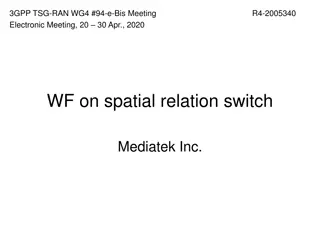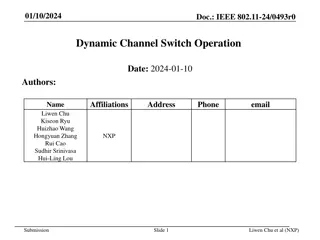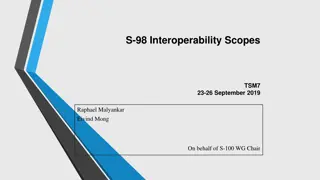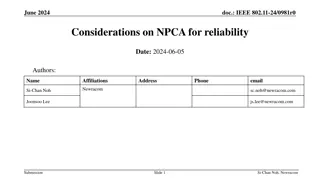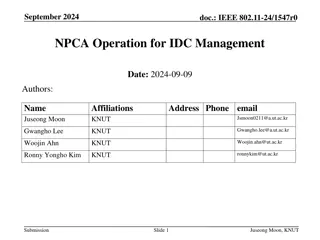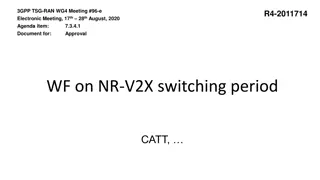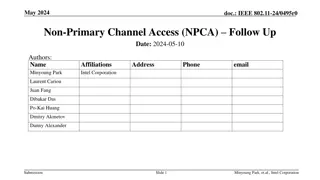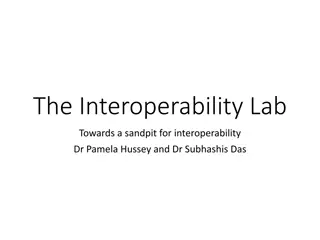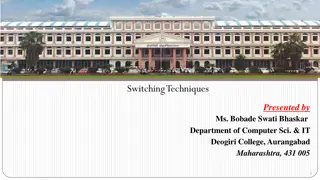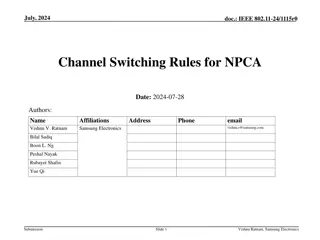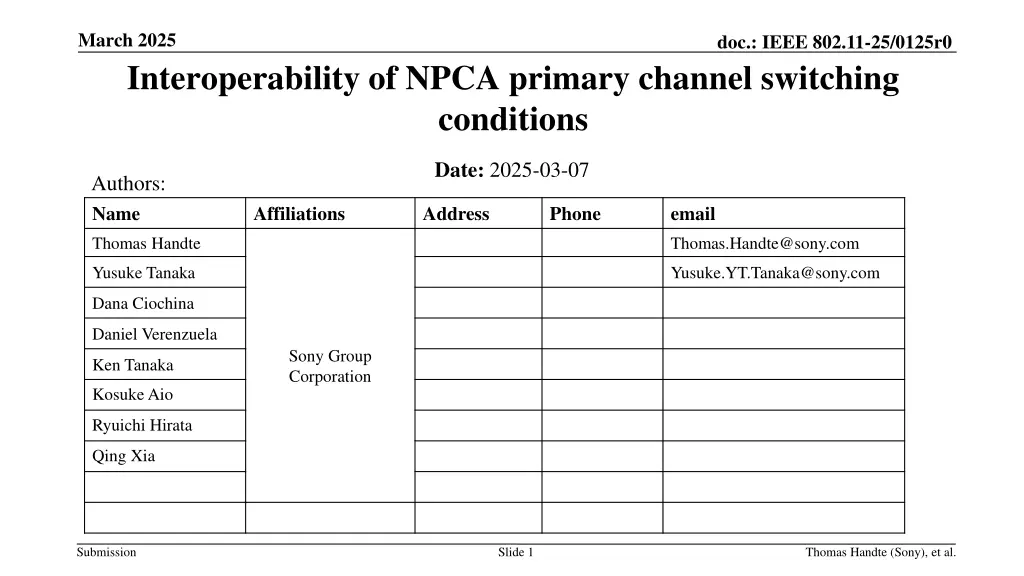
Enhancing IEEE 802.11-25/0125r0 Interoperability for NPCA Primary Channel Switching Conditions
Explore the interoperability issues in NPCA primary channel switching conditions for IEEE 802.11-25/0125r0. Addressing challenges to ensure successful frame exchanges and performance enhancements in OBSS environments.
Download Presentation

Please find below an Image/Link to download the presentation.
The content on the website is provided AS IS for your information and personal use only. It may not be sold, licensed, or shared on other websites without obtaining consent from the author. If you encounter any issues during the download, it is possible that the publisher has removed the file from their server.
You are allowed to download the files provided on this website for personal or commercial use, subject to the condition that they are used lawfully. All files are the property of their respective owners.
The content on the website is provided AS IS for your information and personal use only. It may not be sold, licensed, or shared on other websites without obtaining consent from the author.
E N D
Presentation Transcript
March 2025 doc.: IEEE 802.11-25/0125r0 Interoperability of NPCA primary channel switching conditions Date: 2025-03-07 Authors: Name Affiliations Address Phone email Thomas Handte Thomas.Handte@sony.com Yusuke Tanaka Yusuke.YT.Tanaka@sony.com Dana Ciochina Daniel Verenzuela Sony Group Corporation Ken Tanaka Kosuke Aio Ryuichi Hirata Qing Xia Submission Slide 1 Thomas Handte (Sony), et al.
March 2025 doc.: IEEE 802.11-25/0125r0 Introduction Non-primary channel access (NPCA) is one important enhancement for 11bn Several submissions and motions [1] address the operation The current development state is well captured in a PDT document [2] and D0.1 [3] The design of the conditions, based on which STAs switch to the NPCA primary channel, is crucial for the performance of NPCA Certainly, a STA pair which intends to communicate need both to switch to NPCA primary channel Due to hidden transmissions, STAs may have a different view of the OBSS transmissions Thus, the likelihood that both STAs switch to the NPCA primary channel is anyway less than 100% Therefore, we need to design the switching conditions such that, if both STAs of a pair are affected by OBSS transmissions, the switching to NPCA primary channel and related frame exchange is (almost) always successful This submission addresses an interoperability issue of the current switching conditions and proposes solutions Submission 2 Thomas Handte (Sony), et al.
March 2025 doc.: IEEE 802.11-25/0125r0 Issue Switching to the NPCA primary channel is triggered when any of the following two conditions apply [2] a) a inter BSS PPDU and/or a PHY-RXSTART.indication from a inter BSS HE/EHT/UHR PPDU, or b) a inter BSS control frame exchange is observed and the received frames or PPDUs have certain additional properties [2, 3] STAs may have a different view of an OBSS frame exchange depending on location While a first STA applies condition b), a second STA may apply condition a) because condition b) wasn t fulfilled for the second STA due to a hidden transmission Thus, a first STA may detect a triggering event earlier than a second STA Consequently, the first STA may initiate a frame exchange on NPCA primary channel while the second STA is not yet available, or the first STA may have a channel access advantage Submission 3 Thomas Handte (Sony), et al.
March 2025 doc.: IEEE 802.11-25/0125r0 Example Assumption OBSS STA A and STA B perform a frame exchange The frame exchange consist of RTS, CTS, HE/EHT/UHR PPDU, BAck IBSS STA C may detect all frames IBSS STA D may detect RTS and the HE/EHT/UHR PPDU only i.e., STA B s transmissions are hidden to STA D Switching to NPCA primary channel STA C switches after CTS: condition b) STA D switches after SIG decoding of HE/EHT/UHR PPDU: condition a) Assuming same switching delay, STA C switches earlier than STA D to NPCA primary channel Submission 4 Thomas Handte (Sony), et al.
March 2025 doc.: IEEE 802.11-25/0125r0 Difference in switching times Switching times as seen from an observing STA i.e., a decoding delay later than signal on WM Assumptions NPCA NHT switch time (????) = PHY-RXEND.indication(success) of CTS following RTS NPCA HE switch time (???) = PHY-RXTART.indication(RXVECTOR) Difference is ? = ??? ????= aSIFSTime + ??????? 48 s ? can be larger for PPDUs with additional signaling fields such as E(L)R PPDUs ??????? is 40 s (HE ER, EHT ER, UHR ELR) or 32 s (all other HE, EHT, UHR PPDU formats) Submission 5 Thomas Handte (Sony), et al.
March 2025 doc.: IEEE 802.11-25/0125r0 Implications of different switching times Availability issue A STA may initiate a frame exchange on NPCA primary channel while the peer STA is not yet available A STA can access the medium as early as 34 s (or 25 s) after switching to NPCA primary channel Fairness issue The STA that is earlier present on NPCA primary channel has an advantage in gaining channel access by counting down backoff slots earlier Thus, STAs switching to NPCA primary channel should be available on this channel at (almost) same time Submission 6 Thomas Handte (Sony), et al.
March 2025 doc.: IEEE 802.11-25/0125r0 Solutions Essentially, two options exist 1) Introduce a waiting time 2) Modify the triggering conditions such that regardless of the triggering conditions both STAs are available on NPCA primary channel at (almost) same time Submission 7 Thomas Handte (Sony), et al.
March 2025 doc.: IEEE 802.11-25/0125r0 Option 1) waiting time Currently, there are two conditions triggering the switch to NPCA primary channel Typically, condition b) ( control frame exchange ) detects a OBSS frame exchange faster than condition a) ( PPDU ) Thus, a waiting time should be considered whenever condition b) applies The waiting time is ideally to be considered together with the switching time of a STA A STA that applies condition b) for switching to the NPCA primary channel at NPCA NHT switch time shall initiate a frame exchange on NPCA primary channel not earlier than its peer STA s switching delay and the waiting time has passed. The waiting time is ? , i.e., 48 s or 56 s, subject to the assumptions on slide 5 Submission 8 Thomas Handte (Sony), et al.
March 2025 doc.: IEEE 802.11-25/0125r0 Option 2) modified triggering condition Add to triggering condition b) to switch after a PHY-RXEARLYSIG.indication or PHYRXSTART.indication primitive is received on primary channel after the control response frame following the initiating control frame Such a primitive should be received within aSIFSTime + aRxPHYStartDelay +2x aSlotTime after the PHY-RXEND.indication(success) of control response frame following the initiating control frame This threshold essentially resembles NAVtimeout on primary channel for NPCA Implementing this change results in a ? of 8 s or 16 s which solves the availability issue, but not for the fairness issue We may add a small waiting time of 8 s or 16 s to remove the fairness issue as well Submission 9 Thomas Handte (Sony), et al.
March 2025 doc.: IEEE 802.11-25/0125r0 Conclusion This submission addresses an interoperability issue of the current conditions under which STAs initiate the switch to the NPCA primary channel If, due to hidden transmission issues, STAs detect a OBSS transmission with different conditions, a timing mismatch may occur which results in a first STA starting a frame exchange on the NPCA primary channel, while a second STA is not yet available, or a first STA having a channel access advantage over the second STA Two solutions are suggested to ensure that STAs are available on NPCA primary channel at almost same time regardless the applied switching condition Option 1: Implementation of a waiting time Option 2: Modification of the triggering condition for inter-BSS control frame exchange Submission 10 Thomas Handte (Sony), et al.
March 2025 doc.: IEEE 802.11-25/0125r0 References [1] 11-24/1762r16 PDT-MAC-NPCA [2] 11-24/0209r7 Specification Framework for TGbn [3] P802.11bn D0.1 Submission 11 Thomas Handte (Sony), et al.
March 2025 doc.: IEEE 802.11-25/0125r0 Straw Poll #0 (non-SFD, selects subsequent Straw Poll) Which option do you prefer to address the timing mismatch of NPCA switching conditions (a) implementation of a waiting time (slide 8) (b) modification of the triggering condition inter-BSS control frame exchange (slide 9) (c) Abstain Submission 12 Thomas Handte (Sony), et al.
March 2025 doc.: IEEE 802.11-25/0125r0 Straw Poll #1 Do you agree to add the following to the TGbn SFD? The point in time when a STA may initiate a frame exchange on the NPCA primary channel reflects a waiting time such that STAs are available on the NPCA primary channel at same time, regardless the condition that caused the STA to switch to the NPCA primary channel. - The waiting time is TBD - Whether the waiting time is a fixed value or can be set by AP is TBD Submission 13 Thomas Handte (Sony), et al.
March 2025 doc.: IEEE 802.11-25/0125r0 Straw Poll #2 Do you agree to add the following to the TGbn SFD? In NPCA operation, when the STA received a PPDU containing a Control frame and a PPDU containing an initial response frame of a Control frame exchange on the BSS primary channel the following condition shall be added: - A PHY-RXEARLYSIG.indication or PHYRXSTART.indication primitive is received after the Control frame exchange on the BSS primary channel within TBD time after the initial response frame of the Control frame exchange Submission 14 Thomas Handte (Sony), et al.


